Review: 2012 Mazda5
In the United States, unlike elsewhere in the world, there aren’t many choices for those who need seating for more than five people but who don’t want to give up the maneuverability of a compact car. Kia gave the segment a go, but withdrew the Rondo from the U.S. market a couple of years ago. Chevrolet has opted to not even test the waters with the Orlando. So Mazda currently has the segment to itself. But the Ford C-Max arrives in less than a year. Does the revised 2012 Mazda5 have what it takes to fend off the challenger?
The revised Mazda5 retains its 9/10-scale minivan shape and dimensions, but the previously clean, simple surfacing is gone. A more bulbous nose sports a big grin and fender arches similar to those on the related Mazda3 sedan and hatchback. The sides now have waves stamped into them, the first (and possibly also the last) production embodiment of Mazda’s “Nagare” design language. These waves flow along the tracks for the sliding doors into taillights that are now horizontal and conventionally located rather than vertical and located in the D-pillars. Blacked-out glass resides in the taillights’ former location. To my eye the previous Mazda5 and the C-Max are both more attractive, but the 2012 Mazda5’s exterior styling is gutsier and certainly the most likely to get noticed.
The revised Mazda5 also includes a more highly styled interior, though with more restraint than in the current Mazda3. This is partly a good thing: only the hood over the instruments, which rises to form a point, seems overdone. The instruments’ nacelles shield them from glare, so this hood isn’t only pointlessly pointy—it’s also unnecessary. One appealing upscale detail: red piping and stitching on the Grand Touring’s black leather seats. But the eye of a designer remains needed elsewhere. The door panels remain too flat and too plain and the center console looks like a cheap aftermarket accessory rather than a factory part. Some hard black plastic manages to not look cheap, but not the stuff that covers much of the 2012 Mazda5’s interior. On the whole, the C-Max’s interior is more attractive and better appointed, if perhaps overly styled [Ed: see images in gallery to judge for yourself].
In terms of functionality, the Mazda5 wins back some points—with one major exception. Both vehicles have sliding doors, so no need to worry about the kids dinging neighboring cars in parking lots. Power openers aren’t available, but the doors open and close so easily that these are hardly necessary. From the driver’s seat both seem more like a car than a crossover, but the Mazda’s driving position is better than the C-Max’s, with a more open view over a less imposing instrument panel. The front seats are comfortable in both vehicles, though the Mazda’s are better bolstered. The Mazda’s second-row buckets would be almost as comfortable as those up front if they weren’t a little too low to the floor. The Ford’s are flatter and have unusually low seatbacks—their headrests must be raised about a foot for adult use.
The third-row seats in both microvans are tiny and very low to the floor. In the Mazda, adults up to about 5’10” will fit in a literal pinch, knees against the second-row seatback and head brushing the headliner. Some knee room can be opened up by shifting the second-row seats forward an inch or two, and there is enough room to do this—Mazda claims 39.4 inches of second-row legroom, magically up 4.2 inches from the seemingly similar 2010 and nearly as much as in the first row. The Ford’s third row is even more rudimentary, to the point where Ford is billing it as a 5+2-seater rather than a 7-seater. The difference is just an inch or two, but when you’re near the minimum an extra inch or two can mean the difference between people fitting and not fitting. Pre-teen kids? They’ll fit fine in either.
In the Mazda, rear ventilation is handled a two-speed fan blowing through vents in the rear face of the center console. The air through these vents isn’t as cold as that through the front vents, and the location is less effective than a complete rear HVAC system with vents in the ceiling, but it’s better than nothing.
In the Mazda, there’s just enough space behind the third row to fit a single row of grocery bags. In the Ford, there’s less cargo volume (the specs claim only three cubic feet, vs. 11.3 in the Mazda) and the load floor is higher. Grocery bags will have to be turned to run across the width of the vehicle, so only about half as many will fit. In both vehicles the headrests must be lowered before folding the seats—this doesn’t happen automatically. In neither does the front passenger seat fold to extend cargo space all the way to the instrument panel. While this would have been a useful feature, the way the second row seats fold precludes it.
So, you’re more likely to be able to put kids in both rows AND make a grocery run in the Mazda. But hit the road for a trip and the third seat will have to be folded to make way for luggage in either. Here the C-Max has an advantage for families with three kids. Tucked within the right second-row bucket is a center seat, so it’s possible to seat three kids in the second row. Mazda offers a similar seat in the Mazda5 overseas, but in the United States there’s only a fold-out tray table. So if you want to seat seven people sometimes and five plus luggage at others, the C-Max is the only option.
I have not yet driven the C-Max, but I have driven the 2012 Focus on which it is based. Even if the C-Max drives as well as the Focus, and the microvan’s additional weight and height will likely take their toll, the Mazda5 has some clear driving advantages.
Both microvans are powered by 2.5-liter four-cylinder engines, good for 157 horsepower in the Mazda and 168 in the C-Max. (A 168-horsepower turbocharged 1.6-liter four will also be offered as a more efficient option in the Ford.) Torque differs less, 163 vs. 167 foot-pounds. The Ford’s power advantage should more than be canceled out by its additional curb weight, 3,743 vs. 3,457 pounds. Though the Mazda5’s power-to-weight ratio isn’t promising, around town its acceleration is easily adequate with the five-speed automatic. It helps that the automatic almost always selects the appropriate gear. It’s possible to manually shift the transmission, but this is rarely necessary, even in spirited driving. A six-speed manual is available only in the Mazda, if only in its base trim. When it’s time to stop, the Mazda’s brakes feel reassuringly firm and linear.
The Mazda’s trip computer reported low twenties in suburban driving and high twenties on the highway—cracking 30 requires a healthy tail wind. The EPA reports 21 city, 28 highway. The new Honda Odyssey, a much larger vehicle, matches the latter figure. In Mazda’s defense, it does have a new family of much more efficient engines on the way. The C-Max will likely do about the same with its base engine, a sixth gear in its conventional automatic compensating for its additional mass, while Ford is aiming for 30 on the highway with the turbo.
The Mazda carves out its largest advantage when the road curves. Feedback through its steering and the seat of one’s pants is just about as good as in the Mazda3, and so quite a bit better than in the great majority of cars sold today, including the 2012 Ford Focus. You can distinctly feel the front tires carving their line. The Mazda5 similarly feels more agile and responsive than most compact hatches despite its roughly 3,500-pound curb weight. Lean and body motions are well-controlled, and precisely placing the vehicle quickly becomes second nature. Of the three-row vehicles offered in the U.S., it’s easily the most engaging and most fun-to-drive on a twisty road. At 70+ on the highway, though, the steering can feel twitchy and the tall bodysides are sensitive to crosswinds–the Mazda5 is more in its element at lower speeds. The ride is firm and at times a touch busy, but still generally comfortable. Noise levels are moderate.
Judging from the Focus, the C-Max will feel larger, heavier, and less agile. It will likely handle well, but won’t be nearly as engaging or as fun. On the other hand, it will probably ride more quietly and cushily than the Mazda.
It’s too soon to discuss reliability for either 2012. But the first generation Mazda5 suffered from quite a few suspension problems, based on responses to TrueDelta’s Car Reliability Survey. Perhaps parts based on those for the Mazda3 were not sufficiently upgraded to handle the 5’s extra pounds? Rust is also a common problem with Mazda’s where the roads are salted, and the Mazda5 has been no exception.
The Mazda5’s pricing is up about $900 with the redesign, but remains low for a three-row vehicle. The base trim lists for $19,990, while the leather-trimmed Grand Touring lists for $24,670. A Honda Odyssey EX-L is over $7,000 more even after a $3,000 adjustment for its additional features (using car price comparison tool). Compact SUVs with third row seats are closer in price, but still quite a big higher. The least expensive of these, the Mitsubishi Outlander SE, lists for about $1,000 more, while the Toyota RAV4 is about $2,800 higher before adjusting for feature differences and about $4,100 higher afterwards (chiefly because leather isn’t available with the optional third row). The real competitor will of course be the C-Max. Pricing hasn’t been announced, but judging from that of the related Focus it should be within $500 of the Mazda5’s.
Both the Mazda5 and (soon) the Ford C-Max provide viable solutions for people who need three rows of seating, but who don’t want the bulk (and higher price) that usually comes with them. The Ford has less controversial styling, higher grade materials, and (probably) a smoother, quieter ride. Families with three kids will also appreciate the stowable seventh seat. The Mazda includes a little more room for rear seat passengers and cargo and should retain its title as the best handling three-row people hauler. It’s also the only such vehicle still offered with a manual transmission in the U.S. So while the C-Max will be more likely to win over mainstream car buyers, the Mazda5 should remain the choice for enthusiasts.
Mazda provided the vehicle, insurance and one tank of gas for this review.
Michael Karesh operates TrueDelta, an online source of automotive pricing and reliability data.
Michael Karesh lives in West Bloomfield, Michigan, with his wife and three children. In 2003 he received a Ph.D. from the University of Chicago. While in Chicago he worked at the National Opinion Research Center, a leader in the field of survey research. For his doctoral thesis, he spent a year-and-a-half inside an automaker studying how and how well it understood consumers when developing new products. While pursuing the degree he taught consumer behavior and product development at Oakland University. Since 1999, he has contributed auto reviews to Epinions, where he is currently one of two people in charge of the autos section. Since earning the degree he has continued to care for his children (school, gymnastics, tae-kwan-do...) and write reviews for Epinions and, more recently, The Truth About Cars while developing TrueDelta, a vehicle reliability and price comparison site.
More by Michael Karesh
Latest Car Reviews
Read moreLatest Product Reviews
Read moreRecent Comments
- Rochester I'd rather have a slow-as-mud Plymouth Prowler than this thing. At least the Prowler looked cool.
- Kcflyer Don't understand the appeal of this engine combo at all.
- Dave M. This and the HHR were GM's "retro" failures. Not sure what they were smoking....
- Kcflyer Sorry to see it go. The interior design and color options in particular are rare in the industry
- Wolfwagen Here is my stable. not great not bad I try to do as much as possible. I work for an Aftermarket automotive parts company so I can get most parts at a discount.i try to do as much of my own work as possible. My wife hates that I spend time and money fixing the vehicles but she doesn't want car payments either so...2019 VW Atlas 50K (wife's) Only issues so far were Brakes and normal maintenance.A Bad Cat Converter which was covered and a replacement of the rear bank head gasket which was a manufacturing defect due to improper torquing at the factory. All under warranty2003 Saab 9-5 Arc Wagon (my DD) 116 K picked up used last year. Replaced Struts, brakes, hatch struts, motor mounts, D/S swaybar link, Timing belt, water pump and thermostat Power steering pump Fuel pump, Both Front window regular rollers, Heater core and cabin air filter. Oil and transmission changes. Love the car but Saab/GM packaging is a nightmare.2005 Cadillac Deville (former DD now Son # 1 DD) picked up used 5 years ago with only 47K now 83K Plugs, coils, P/s pump, Water pump, hoses, P/S lines (mechanic job) evap valve, brakes, Front brake calipers and rear brake calipers. Currently has oil pan gasket leak - looking to have a mechanic do that2009 Mini Cooper (Daughters dd)picked up 2 years ago 67K Brakes and thermostat house to clear check engine light2001 Mazda Tribue (Son#2 dd) 106K picked last summer after he severely damaged a 2004 Hyundai accent. Oil changes




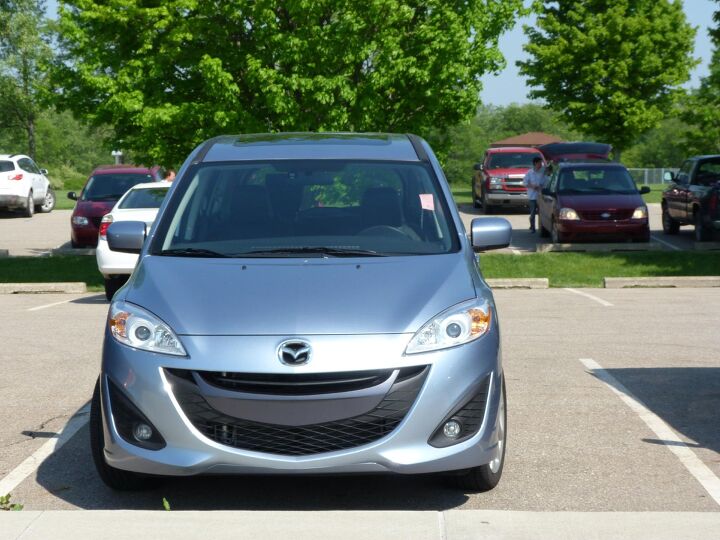






























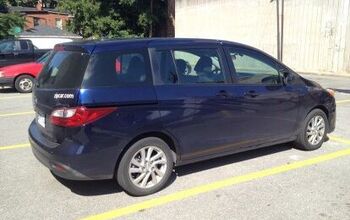

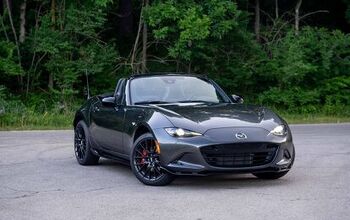
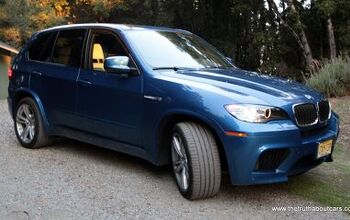
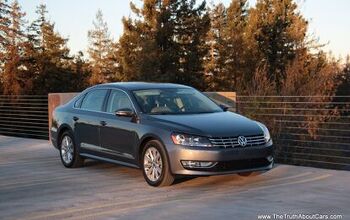










Comments
Join the conversation
I do agree, fuel economy is not a real reason to chose the smaller 5 over a "big" minivan, at least not of 90% of your driving is freeway. In our case, most driving in this car is around town and short freeway hops with a few longer trips thrown in. In stop and go driving we average around 24-25 mpg, which is better than a heavier v6 van will do, but Mazda in general does relatively poorly in terms of freeway economy. Taller gearing could certainly improve the 5 here as well as in noise levels. On the other hand, we bought out 2008 Grand Touring (no nav) for about $19,500 and the car still had a sticker price under $22k. I don't believe you can get a base Odyssey for anywhere near that price much less one with the luxury features you mention. We also preferred the 5 because it is easier to drive, park, and just generally live with on a daily basis than a larger vehicle we just don't really need. Most of the time our third row is just folded flat and it is a roomy 4-seat vehicle. For us, the third row is a bonus feature on rare occasions. We did have one son in a rear-facing seat until recently and it was tight but did fit. If you are 5'8" or more, though, I would recommend you try this before buying.
Those EPA mpg numbers on the Odyssey's are optimistic. Now that many friends have mini vans we compare notes. No one that has an Odyssey sees over 20mpg in mixed driving. One guy said he gets 16mpg. The one minivan that is surprising is the Sienna (3.5l), and those guys say they get ~22mpg mixed. I think the Toyota V6 is very economical.